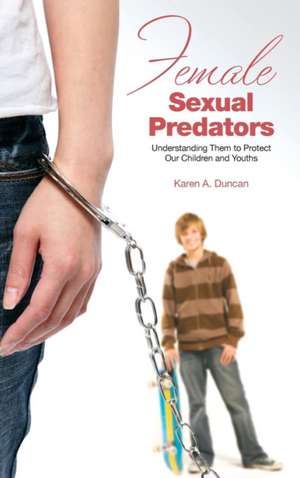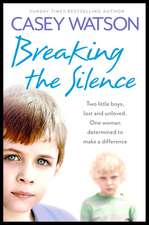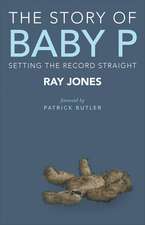Female Sexual Predators: Understanding Them to Protect Our Children and Youths
Autor Karen A. Duncanen Limba Engleză Hardback – 19 iul 2010 – vârsta până la 17 ani
Preț: 309.37 lei
Preț vechi: 359.29 lei
-14% Nou
Puncte Express: 464
Preț estimativ în valută:
59.25€ • 61.04$ • 49.63£
59.25€ • 61.04$ • 49.63£
Carte tipărită la comandă
Livrare economică 22 februarie-08 martie
Preluare comenzi: 021 569.72.76
Specificații
ISBN-13: 9780313366291
ISBN-10: 0313366292
Pagini: 264
Dimensiuni: 156 x 235 x 28 mm
Greutate: 0.57 kg
Editura: Bloomsbury Publishing
Colecția Praeger
Locul publicării:New York, United States
ISBN-10: 0313366292
Pagini: 264
Dimensiuni: 156 x 235 x 28 mm
Greutate: 0.57 kg
Editura: Bloomsbury Publishing
Colecția Praeger
Locul publicării:New York, United States
Caracteristici
Features international studies on the crimes females commit against children and youths, providing the reader with a crosscultural view of female sexual offenders
Notă biografică
Karen A. Duncan, LSW, LMFT is a licensed therapist and social worker, as well as a member of the editorial board for the Journal of Mental Health Counseling.
Cuprins
AcknowledgmentsIntroduction1 Female Sexual Offenders: A Changing PerspectiveClarifying Crime Reports and Prevalence StudiesDiverse Characteristics of Female Sex OffendersDo Men Coerce Women to Commit Sexual Crimes?Female Sex Offenders and ViolencePrior Sexual Victimization and Female Sexual OffendingUnderstanding Female Sexual OffendingThe Risk to African American Boys by Female Sex OffendersProfessional Bias and Gender StereotypesThe Importance of Sexist-Free LanguageChapter Summary2 Breaking the Silence about Maternal Sexual AbuseThe Reality of Maternal Sexual AbuseThe Myth of the Incest TabooBarriers to Disclosing Maternal Sexual AbuseCharacteristics of Maternal Sexual OffendersTypes of Sexual Offenses Mothers CommitA View of the Impact of Maternal Sexual AbuseRelinquishing the Iconic Image of MotherChapter Summary3 Female Sexual Coercion and Aggression in College Dating RelationshipsMoving Beyond Gender StereotypesPromoting an Honest and Respectful DialogueFemale Sexual Aggression and Male VictimizationAlcohol and the Risk for Sexual CoercionGreek Membership: A High-Risk Environment for Sexual CoercionAdversarial Beliefs, Love Styles, and Sexual CoercionChapter Summary4 Sexual Exploitation and Sexual Harassment in SchoolsA Review of Findings from the U.S. Department of Education (2004) Study on Educator Sexual Misconduct in SchoolsFemale Sexual Predators in Schools: It Happens to Girls TooLaura's StoryJoanna's StoryThe Celebrity CoachSexual Harassment in SchoolsSexualized School EnvironmentsTeachers' Participation in Sexual HarassmentAmy's StoryChapter Summary5 Future DirectionsFemale Sexual DevianceOverview of Emerging TypologiesTreatment Components with Female Sexual OffendersThe Possibility of Preventing Child Sexual AbuseChapter SummaryAppendicesAppendix A Adversarial Beliefs Inventory© (ABI-Heterosexual Females)©Appendix B Beliefs about Male Rape© (BAMR)©Appendix C Justification of Sexual Aggression (JSA-Heterosexual Female)©Appendix D Assessment of Sexual Assertiveness© (ASA)©NotesBibliographyIndex
Recenzii
Duncan has created a book that could be equally helpful to a sexual assault survivor, family member, or concerned layperson . Duncan brings a clinical perspective to the subject through vignettes and other examples that carry detail and richness to the concepts she is working to explain. . . . As a means of prevention through raising awareness, this easily readable book provides a resource not reliant on the full understanding of statistical methods. She does a wonderful job at exploring dynamics seldom seen in the literature, such as the reference to female sexual aggression on college campuses. Furthermore, the vignettes found in her section on child sexual assault at the hands of educational professionals provide an insight that could prove remarkably helpful to those most in need. . . . Duncan's Female Sexual Predators could find applicability in the larger contexts of the helping professions, the concerned community, and as a phenomological tool for survivors and those concerned about them .










